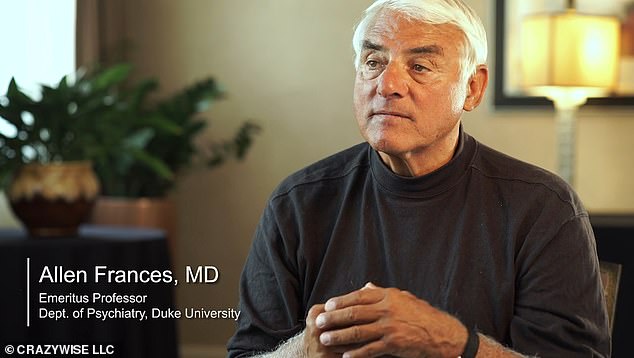[ad_1]
A leading psychiatrist has revealed his ‘guilt’ over America’s spiraling autism crisis, after his team’s work led to an explosion in cases — and fueled the anti-vaccine movement.
In the 1980s, around one in 2,000 children had autism in the US.
But by the turn of the century, this had jumped 13-fold to one in 150 children, in large part due to Dr Allen Frances and his team’s updated guidelines for diagnosing autism.
For the first time, doctors began recognizing Asperger’s syndrome — a milder condition where patients develop in a typical way in early life but tend to have difficulty with social cues, empathy and forming relationships — as a form of autism.
In 2013, building on his team’s work, the definition was loosened yet again to include even milder cases, and autism was re-defined as ‘autism spectrum disorder’.
The result was, according to Dr Frances, that children were ‘labeled with a serious condition for challenges that would better be viewed as a variation of the normal’.
Today, around one in 31 children have autism spectrum disorder.
Speaking to the BBC, Dr Frances said: ‘It’s a kind of mea culpa — we had good intentions that led to terrible unintended consequences.

Dr Allen Frances, a top psychiatrist, led an update to the guidelines for diagnosing autism in 1994 that loosened the definition to include people with milder symptoms
‘I feel very guilty that through our well-meaning but misguided efforts, we’ve contributed to the anti-vax movement.’
‘It was absurd [the link between vaccines and autism], I knew the problem was definitional and increased assessment and popularity of diagnosis, not vaccines.’
The Duke University professor led the team that updated the Diagnostic and Statistical Manual of Mental Disorders (DSM) in 1994, which sets the definition of conditions like autism.
His team loosened the definition amid requests from child psychiatrists and pediatricians who said the extremely stringent criteria were leaving children with similar symptoms, but milder, without access to health services.
Health insurance generally only covers autism treatment — speech therapy and strategies to manage symptoms — for people diagnosed with the condition.
At the time, the team’s modeling predictions suggested that loosening the definition would have only a modest impact on diagnostic rates.
Dr Frances added: ‘What we did was introduce something called Asperger’s disorder, and that evolved into autism spectrum disorder — which can be ever so much more mild in its presentation and therefore very much more common.
‘So this meant that the symptoms of autism as currently used or defined by many clinicians, and certainly self-defined by patients and families, would include many people who have normal social awkwardness, eccentricities, difficulties relating to people that previously would never have been considered a mental disorder.
‘But now, because of the loosened definition, because of the fact that school services are tied to having the diagnosis of autism, and perhaps most of all because of the internet popularity of self-diagnosis… we have this enormous increase in rate.’
He added in an op-ed in the New York Times that cases were further skyrocketing because autism spectrum disorder was so difficult to diagnose.
‘There is no biological test; symptoms vary greatly in nature and severity; clinicians don’t always agree; different diagnostic tests may come up with different conclusions; and the diagnosis is not always stable over time,’ he wrote.
‘Diagnostic inaccuracy contributes to falsely elevated rates, which can lead to misconceptions that an “epidemic” is occurring.’
Health Secretary Robert F. Kennedy Junior has vowed to find the cause of spiking autism diagnoses, which he blames on ‘environmental toxins.’
In April, he said he would commission a series of studies into whether mold, pesticides, food chemicals or medicines were raising the risk of developing the condition.
RFK Jr also raised the possibility that ultrasound scans, used routinely to monitor babies before birth, could be behind the surge.
As well as children, about 5.4million adults, equivalent to about one in 45 people, are now considered to have autism in the US.
Experts are increasingly raising concerns over autism misdiagnoses, saying some people told they have the condition may instead have something else.
A 2020 review study found of those diagnosed with autism 20 percent had anxiety disorders while 11 percent had depressive disorders.

Among famous people who say they have autism is Elon Musk, pictured above last year while attending the Breakthrough Prize Awards in Los Angeles
Meanwhile, Dr Frances said that autism diagnoses in children should not be viewed as permanent, like they currently are.
‘Diagnoses in kids, particularly, should be written in pencil,’ he said, ‘because they are so often unreliable and unstable’.
‘Instead, there’s a tendency that once a diagnosis is made it gets on medical charts and it’s sort of written in stone.
‘It lasts forever and it can haunt someone for the rest of their life who had a misdiagnosis of autism early in their life, and who changed self-expectations and external expectations as a result.’
Donald Trump has vowed to ‘get to the bottom’ of the uptick in autism rates in the US, saying in an interview that there was ‘something going on’.
He wrote on Truth Social, his social media platform, in March: ’20 years ago, autism in children was one in 10,000. NOW IT’S 1 in 34. WOW! Something’s really wrong. We need BOBBY!!! Thank You! DJT.’
[ad_2]
This article was originally published by a www.dailymail.co.uk . Read the Original article here. .

